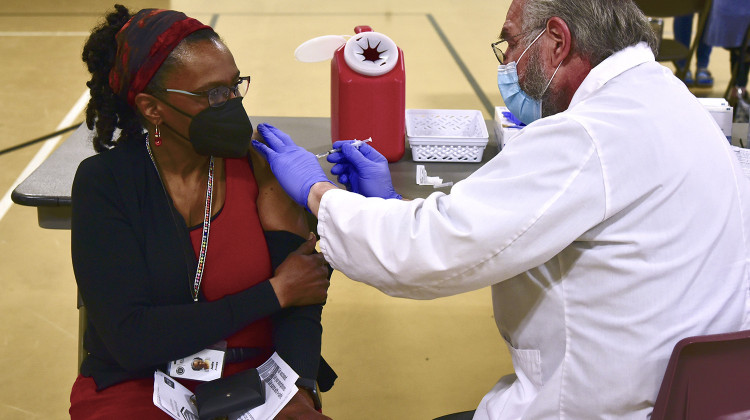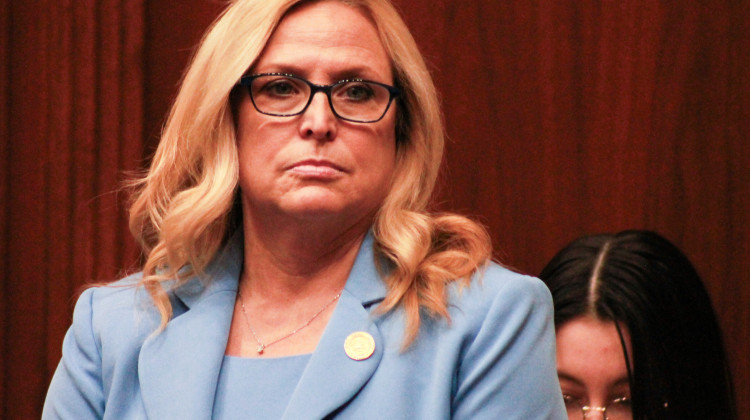
Indiana has administered 1,270,966 initial vaccine doses, with 830,862 Hoosiers fully vaccinated.
Justin Hicks/IPB NewsThe Indiana Department of Health reported 136 additional confirmed deaths over the last week. That brings the state’s total to 12,446 confirmed deaths. The state also reported more than 5,000 new cases in the last week.
Indiana has administered 1,270,966 initial vaccine doses, with 830,862 Hoosiers fully vaccinated.
Here are your statewide COVID-19 headlines from last week.
Teachers Can Get COVID-19 Vaccine At State Sites, Indiana Adds New Comorbidity Eligibility
Indiana K-12 teachers, school staff and child care workers can get the COVID-19 vaccine at any site in the state, starting Monday.
Last week, the Biden administration made the vaccine available for educators through federal pharmacy program sites – in Indiana, Kroger, Meijer and Walmart – the week of March 8.
Gov. Eric Holcomb said the federal government went a step further – asking state vaccination sites to also expand to teachers.
The state announced Wednesday it’s also expanding vaccine eligibility to include more comorbidities.
The new eligibility includes:
- Cystic fibrosis
- Muscular dystrophy
- People born with severe heart defects, requiring specialized medical care.
- People with severe type 1 diabetes, who have been hospitalized in the past year.
- Phenylketonuria (PKU), Tay-Sachs, and other rare, inherited metabolic disorders.
- Epilepsy with continuing seizures, hydrocephaly, microcephaly and other severe neurologic disorders
- People with severe asthma who have been hospitalized for this in the past year
- Alpha and beta thalassemia
- Spina bifida
- Cerebral palsy
- People who require supplemental oxygen and/or tracheostomy
- Pulmonary fibrosis, Alpha-1 Antitrypsin
- Immunocompromised state (weakened immune system) from blood or bone marrow transplant, immune deficiencies, combined primary immunodeficiency disorder, HIV, daily use of corticosteroids, use of other immune weakening medicines, receiving tumor necrosis factor-alpha blocker or rituximab.
READ MORE: How Will Indiana Distribute COVID-19 Vaccines? Here's What You Need To Know
Join the conversation and sign up for the Indiana Two-Way. Text "Indiana" to 73224. Your comments and questions in response to our weekly text help us find the answers you need on COVID-19 and other statewide issues.
CDC Releases Guidance On Social Distancing, Mask-Wearing For Vaccinated People
The CDC released its first public health recommendations March 8 for people who are fully vaccinated – which is up to two weeks after receiving the last required dose for Pfizer-BioNTech, Moderna and Johnson & Johnson.
Fully vaccinated people can:
- Visit with other fully vaccinated people indoors without wearing masks or physical distancing
- Visit with unvaccinated people from a single household who are at low risk for severe COVID-19 disease indoors without wearing masks or physical distancing
- Refrain from quarantine and testing following a known exposure if asymptomatic
But there’s a big caveat to the CDC’s recommendations: mask-wearing and social distancing still need to happen in public. According to NPR’s Shots, studies of the new vaccines only measured whether vaccinated people developed symptoms, not whether they got infected. It's possible that they got mild infections — not enough to make them ill, but enough to pass the virus on to others. So, for the safety of others, you still need to wear a mask.
Indiana Rental Assistance Applications Now Open
Hoosiers in need of help paying their rent can now apply to the state for assistance.
Households are eligible if at least one person qualifies for unemployment, had income loss during the pandemic, incurred significant costs or experienced a financial hardship over the last year.
The household income must also be no more than 80 percent of the area median income – for a family of four, that’s about $58,000.
Applications are now available at IndianaHousingNow.org for people in most counties.
Residents of Elkhart, Marion, Lake, Hamilton, and St. Joseph counties, as well as Fort Wayne must apply to local programs.
Amid COVID-19 Crisis, MIS-C Hits Black And Latinx Kids Hard
At Riley Children’s Hospital in Indianapolis, Dr. Samina Bhumbra has been receiving calls for help from health centers across the state. Callers describe children with symptoms such as high fever, red eyes, swollen lips and abdominal pain.
To Bhumbra, an assistant professor of clinical pediatrics, that can point to a potentially fatal condition known as MIS-C. It’s rare, but appears to be increasing with every COVID surge.
Multisystem Inflammatory Syndrome in Children has become all too familiar to Riley’s specialists. They’ve seen dozens of cases.
“It's still a very rare phenomenon today,” Bhumbra says. “There have been about three million COVID cases in children since the beginning of the pandemic. But really, about 2,000 children have been diagnosed with MIS-C.”
The condition is characterized by severe inflammation that affects organs like the heart and lungs. MIS-C can happen during a COVID infection or weeks later — even when a child hasn’t shown symptoms of the virus.
At least 33 children have died nationwide.
MIS-C affects every child differently, and doctors are unsure why some develop it and others don't. But they say it’s hitting Black and Latinx children especially hard.
Here's What Unemployed Hoosiers Should Know About The American Rescue Plan
President Joe Biden signed the American Rescue Plan into law Thursday, intended to provide economic stimulus to those hardest hit by the COVID-19 pandemic. Here's what it means for unemployed Hoosiers.
The federal law will provide unemployed Hoosiers with an extra $300 per week of unemployment benefits and keep federal unemployment programs going through early September. The most recent data shows that even in December 2020, DWD was issuing unemployment payments to more than 200,000 Hoosiers.
However, before that actually goes into effect in Indiana, the Department of Workforce Development will have to wait for guidance from the U.S. Department of Labor. DWD said it’s working diligently to try to avoid gaps in payments although previous federal benefits are set to phase out at the end of the week.
Indiana Bus Driver, Instacart Shopper Reflects On Working Through A Pandemic
It’s been a year of living through the COVID-19 pandemic in Indiana. Throughout it, many front-line workers confronted personal fears to keep schools and businesses running. Melissa Rose from Valparaiso was one of them, working both as a bus driver and as a personal shopper for the grocery delivery app, Instacart. Indiana Public Broadcasting’s Justin Hicks worked with Melissa to produce this story.

My day usually starts very early. I’m up at 4 a.m. and I’m out of the house by 6 every morning, [to] get on my school bus. Sometimes that drive to school, especially in the wintertime, can be tricky at best.
Not much has changed in the world of the school bus.
When we did go back to school in August after being gone for March, I was petrified. I’m expected to go be locked in a box with 40 kids. Crazy, right? But, knock on wood, it has been OK for me so far – but the anxiety? Oh boy. Oh boy.
Lawmakers Clash With Administration Officials Over Emergency Powers Bills
Lawmakers had tense exchanges with members of Gov. Eric Holcomb’s administration Thursday over legislation that would curb the governor’s emergency powers.
Those bills, including HB1123 and SB407, are a reaction to Holcomb’s orders during the COVID-19 pandemic. They would empower the General Assembly to act during long-term emergencies and would handcuff the governor from taking some of the same steps he took during the pandemic.
State Health Commissioner Dr. Kris Box said the emergency powers are crucial.
“Because of the foresight of this body decades ago to create this once-in-a-lifetime emergency authorities, we have been able to save lives through COVID-19 testing, contact tracing and PPE distribution,” Box said.
Carbon Emissions Went Back Up As COVID-19 Restrictions Lifted
Though carbon emissions went down during Stay-At-Home orders last year, the pandemic may not have had as much of an effect on air quality in 2020 as we once thought. A professor at IUPUI says as restrictions lifted, carbon emissions went right back up.
IUPUI earth sciences professor Gabriel Filippelli and his team found that, during the lockdown, Indianapolis’s air quality improved by 25 percent compared to the previous five years. They saw similar decreases in the other cities they studied.
But when businesses reopened and people started driving again, Filippelli said the trend reversed. As a result, he said carbon emissions in the U.S. only went down by about 12 percent in 2020 compared to the previous year.
Emissions could climb even more as people get vaccinated and more restrictions are lifted.
Contact Lauren at lchapman@wfyi.org or follow her on Twitter at @laurenechapman_.
 DONATE
DONATE






 Support WFYI. We can't do it without you.
Support WFYI. We can't do it without you.